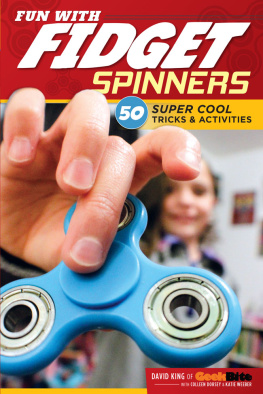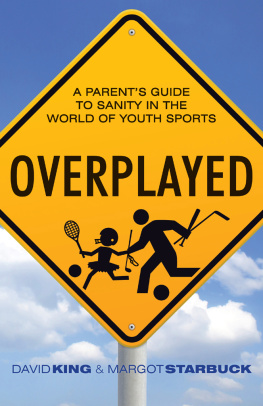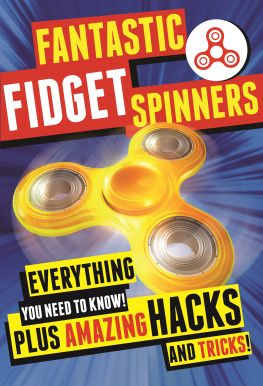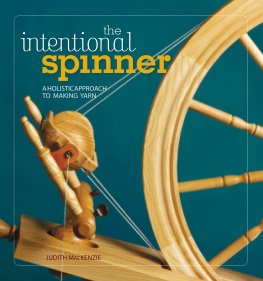Stop Fidgeting and Other Bad Advice
Youve probably heard it from your parents or your teachers: Stop fidgeting! Or maybe: Please sit still! When youre doing something that requires concentration, like studying or listening in class, youre supposed to sit quietly, focus, and do your work from start to finish without interruption. If you find this way of working frustrating, youre not alone! Sitting still is hard for lots of people, not just you.
In fact, were learning more and more that trying to sit still and focus is counterproductive, and that most people work best when they have something else to do. Scientists have found that when kids use fidget toys, attention and focus in the classroom setting seem to get better. In story after story, a hyperactive kid finds a new sense of calm and balance when theres a fidget spinner in his hand. But the jury is still out on exactly how helpful fidget spinners are. This is no surprise, really, since these gadgets are so new to our culture.
While there might not be a ton of research out there on fidget spinners specifically, there have been studies about the act of fidgeting itself. Scientists who study how adults behave at work have found that fidgeters live longer than non-fidgeters because even a little bit of motion is better than no motion. Another well-established discovery is that taking short brain-breaks actually increases attention. If your parents are supposed to move around at the office and take breathers from their work, why not you! After all, tests are hard and theres not much downtime at school.
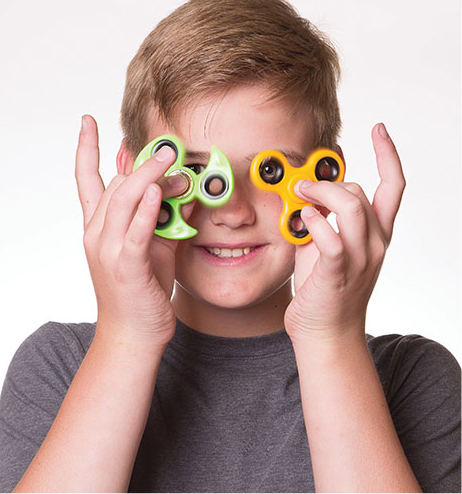
The Origin Story
You probably wont believe it, but the fidget spinner has been around in different forms since 1993! Many credit Catherine Hettinger with the invention of this toy. At the time, Catherine was recovering from an illness that left her very weak. In order to play with her seven-year-old daughter, Catherine needed a toy that was lightweight and didnt take a lot of energy to operate, but also something that was fun and would hold her daughters attention. Catherine used stuff lying around her house to rig up a little spinny thingythe first fidget spinner. It was a hit with her daughter, so Catherine continued to refine her design and eventually patented it in 1997. Sadly, toy companies werent ready for her invention, and Catherine unfortunately let her patent expire in 2005. Some say that if Catherine had held on to her patent, shed be swimming in offers for her cool design today. Others argue that todays fidget spinners differ enough from Catherines design that her patent wouldnt cover them. Check out the research online. What do you think?
But why is fidgeting so effective for some people in aiding concentration? One reason just might be how were hardwired as a species. Think about it. Once upon a time, people spent most of their days hunting, farming, or foraging for food. Fidgeting would have been a waste of precious energy. While we dont live that way anymore, our bodies are still built for that lifestylealways ready for action. No wonder we want to stay in motion! Fidgeting is how we modern humans let out some of that bottled up, leftover energy.
What Is a Fidget?
Here are some examples of fidgets that adults commonly use, and they may work for you, too. Remember, a true fidget should not distract from your primary task, and it should not be distracting to others in your classroom. Some more active fidgets like walking or spinning in a chair can be done at home. Common fidgets: playing with your hair or clothes; doodling; walking; bouncing, spinning, or rocking your chair; listening to music without lyrics or other white noise; chewing gum; tapping or playing with your pen.
Another reason fidgeting is useful, especially when it comes to concentration, is that it can keep your mind from wandering and help you focus on the task at hand. By engaging in some minor physical activity, you occupy the part of your brain thats likely to get bored. This way, the rest of your brain is free to concentrate on your teacher, your homework, or your science project and is not distracted by questions like: When is class over? What am I going to have for lunch today? The fidgeting takes the place of that mind wandering.
Just because fidgeting is good for you doesnt mean you should start running laps around your classroom or playing games with your classmates while your teacher is talking. Believe it or not, a fidget has specific limits attached to it. The important thing, according to experts, is that it is felt and not watched. Easy to ignore, in other words. The fidget cant be something so interesting that it takes over your full concentration. So, no, you cant claim that playing video games will help you finish your homework, but pressing buttons on a disconnected controller might!
Its also important that your fidget is not distracting to others. It seems like every other day another school puts the kibosh on fidget spinners in the classroom. Entire districts from Chicago to Brooklyn have banned them. The reason many teachers dont like them is, they say, that even students who dont have their own fidget spinners are distracted by the showing off of those who do. The white noise that spinners make can also be irritating during quiet work sessions, like during a test. If you happen to be one of the lucky students whos still allowed a spinner at your desk, try to keep it that way by using your spinner as a tool for concentration when class is in session and saving the tricks for outside of school.
Whether you believe that fidget spinners help you cope with anxiousness or that theyre cool toys and nothing more, its a good idea to enjoy them without letting them distract you from whats really important (like your grades). You can use them to dazzle friends, classmates, and family with your feats of dexterity. They can be an exciting puzzle for you to figure out the physics of spinning objects. With no logging on or levels to beat, they let you do something with your hands that also relaxes your mind. Best of all, they can give you those little brain breaks that make everything else in your day feel more satisfying. Fidgeting is healthy! Keep that in mind the next time someone tells you to stop playing with your fidget spinner and concentrate. And then ask them what their favorite fidget toy is
In this book, we show you all about spinnershow they work, what types are available, and how to get the most out of yours so that youll be a spin master in no time. So lets get started, and, yes, keep up that spinning!

Ready, Set, Spin: All About Spinners
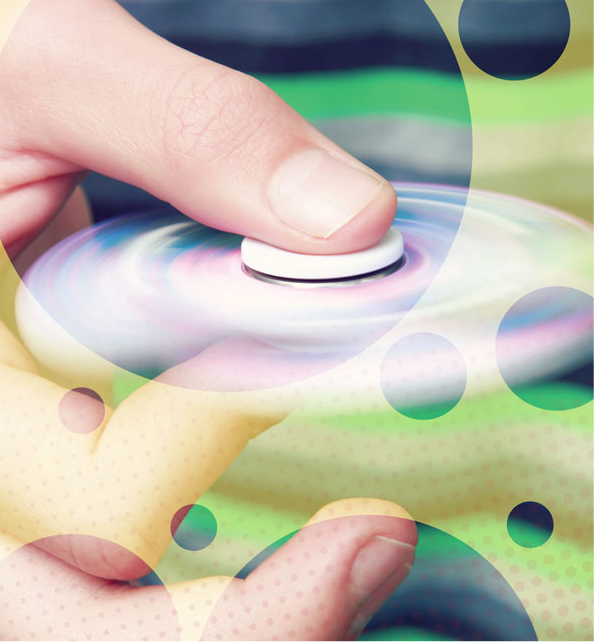
So you have a collection of fidget spinners and have had some fun with them. Nowhow can you make them go faster and learn some epic tricks that will secure your fidget spinner mastery? To help boost your spinner speed and trick difficulty, it might help to learn a little bit about how your fidget spinner is made and how it works. Fidget spinners are not just toystheyre actually little machines with a whole lot of physics behind them. With the power of knowledge on your side, the next time a teacher or parent scoffs at you for spinning your toy, you can school them with a physics lesson, fidget-spinner style.
How Theyre Made
Your fidget spinner has four basic parts: a central spinning hub (usually a ball bearing), the housing, weights, and caps (or fingerpads).
Next page
